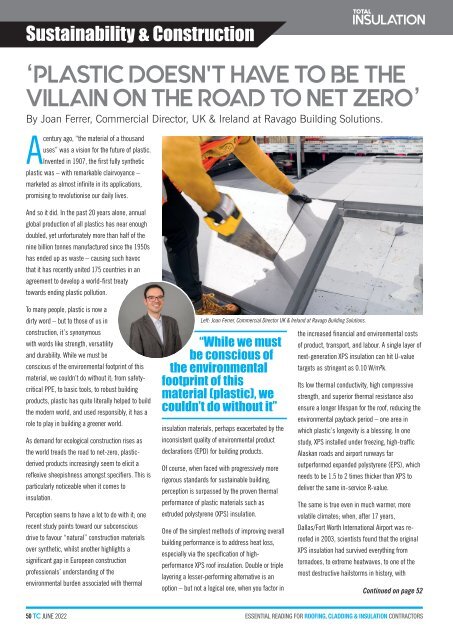June 2022
You also want an ePaper? Increase the reach of your titles
YUMPU automatically turns print PDFs into web optimized ePapers that Google loves.
Sustainability & Construction<br />
‘PLASTIC DOESN'T HAVE TO BE THE<br />
VILLAIN ON THE ROAD TO NET ZERO’<br />
By Joan Ferrer, Commercial Director, UK & Ireland at Ravago Building Solutions.<br />
Acentury ago, “the material of a thousand<br />
uses” was a vision for the future of plastic.<br />
Invented in 1907, the first fully synthetic<br />
plastic was – with remarkable clairvoyance –<br />
marketed as almost infinite in its applications,<br />
promising to revolutionise our daily lives.<br />
And so it did. In the past 20 years alone, annual<br />
global production of all plastics has near enough<br />
doubled, yet unfortunately more than half of the<br />
nine billion tonnes manufactured since the 1950s<br />
has ended up as waste – causing such havoc<br />
that it has recently united 175 countries in an<br />
agreement to develop a world-first treaty<br />
towards ending plastic pollution.<br />
To many people, plastic is now a<br />
dirty word – but to those of us in<br />
construction, it’s synonymous<br />
with words like strength, versatility<br />
and durability. While we must be<br />
conscious of the environmental footprint of this<br />
material, we couldn’t do without it; from safetycritical<br />
PPE, to basic tools, to robust building<br />
products, plastic has quite literally helped to build<br />
the modern world, and used responsibly, it has a<br />
role to play in building a greener world.<br />
As demand for ecological construction rises as<br />
the world treads the road to net-zero, plasticderived<br />
products increasingly seem to elicit a<br />
reflexive sheepishness amongst specifiers. This is<br />
particularly noticeable when it comes to<br />
insulation.<br />
Perception seems to have a lot to do with it; one<br />
recent study points toward our subconscious<br />
drive to favour “natural” construction materials<br />
over synthetic, whilst another highlights a<br />
significant gap in European construction<br />
professionals’ understanding of the<br />
environmental burden associated with thermal<br />
Left: Joan Ferrer, Commercial Director UK & Ireland at Ravago Building Solutions.<br />
“While we must<br />
be conscious of<br />
the environmental<br />
footprint of this<br />
material (plastic), we<br />
couldn’t do without it”<br />
insulation materials, perhaps exacerbated by the<br />
inconsistent quality of environmental product<br />
declarations (EPD) for building products.<br />
Of course, when faced with progressively more<br />
rigorous standards for sustainable building,<br />
perception is surpassed by the proven thermal<br />
performance of plastic materials such as<br />
extruded polystyrene (XPS) insulation.<br />
One of the simplest methods of improving overall<br />
building performance is to address heat loss,<br />
especially via the specification of highperformance<br />
XPS roof insulation. Double or triple<br />
layering a lesser-performing alternative is an<br />
option – but not a logical one, when you factor in<br />
the increased financial and environmental costs<br />
of product, transport, and labour. A single layer of<br />
next-generation XPS insulation can hit U-value<br />
targets as stringent as 0.10 W/m²k.<br />
Its low thermal conductivity, high compressive<br />
strength, and superior thermal resistance also<br />
ensure a longer lifespan for the roof, reducing the<br />
environmental payback period – one area in<br />
which plastic’s longevity is a blessing. In one<br />
study, XPS installed under freezing, high-traffic<br />
Alaskan roads and airport runways far<br />
outperformed expanded polystyrene (EPS), which<br />
needs to be 1.5 to 2 times thicker than XPS to<br />
deliver the same in-service R-value.<br />
The same is true even in much warmer, more<br />
volatile climates; when, after 17 years,<br />
Dallas/Fort Worth International Airport was reroofed<br />
in 2003, scientists found that the original<br />
XPS insulation had survived everything from<br />
tornadoes, to extreme heatwaves, to one of the<br />
most destructive hailstorms in history, with<br />
Continued on page 52<br />
50 TC JUNE <strong>2022</strong>

















